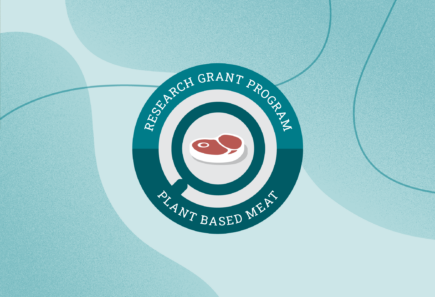
Reimagining soy: flavor and function
Years active: 2024This project upcycles non-GMO soybean meals into premium ingredients with improved flavor and function through innovative processing.

This project upcycles non-GMO soybean meals into premium ingredients with improved flavor and function through innovative processing.
Creating a catalog of molecules responsible for the characteristic flavor of a species will enable alternative protein product manufacturers to create products that more accurately replicate the sensory experience of animal meats, removing a major barrier to their widespread adoption.
The identification of non-animal, non-recombinant proteins with similar functionality to serum albumin and transferrin will lead to major cost reductions in cell culture media development, facilitating progress toward achieving price parity with cultivated meat.
Plant-based protein makerspaces would be publicly available spaces where interested members of the public could learn, experiment, and work collaboratively on projects related to plant-based proteins. They could offer access to the physical equipment necessary to conduct projects as well as technical assistance to inform them. The aim would be to encourage more interaction between the public and the alternative protein industry, thus stimulating the exploration and development of more ideas. Makerspaces may also be able to increase positive consumer perception of the technology by increasing familiarity with the relevant production processes. The logistics of the makerspace should be done in such a way to maximize democratization and inclusion of a large segment of the public.
In order to appeal to health-conscious consumers, alternative seafood products should contain similar omega-3 fatty acids, especially DHA and EPA, content to conventional seafood. Animal-free omega-3 ingredients can be expensive and supply can be inconsistent. Scaling up animal-free omega-3 production is critical to the success of the global alternative seafood market, which is seeing increased attention and promising growth. Adding omega-3 to other alternative protein products could also provide a great point of differentiation while improving health appeal.
Deeper fundamental knowledge of the causes and prevention of oxidation of omega-3 fatty acids before, during, and after addition to alternative seafood products is needed to improve their nutritional and organoleptic properties. While several approaches to prevent oxidation of unsaturated lipids in conventional seafood products have been developed, antioxidation methods must be tailored to the formulations and processing of alternative seafood products, or perhaps new methods must be developed altogether.
Plants can serve as expression platforms similar to microorganisms used as recombinant protein hosts. This may require minimal processing into value-added ingredients, such as egg and dairy functional proteins. Plants offer scalability with less need for expensive downstream purification to isolate proteins of interest from inedible or undesirable hosts.
Opportunities exist to coordinate product development partnerships between ingredient suppliers, strategic partners, and product manufacturers to directly engage more holistically on product formulation.
Plant-based food manufacturers often struggle with batch-to-batch ingredient inconsistency and variability between suppliers. Better analytical tools for predicting plant-based ingredient performance could improve manufacturing efficiency and create more transparent ingredient markets. Tools are needed to predict how ingredients will perform after various processing methods and in end-product applications like plant-based meat and dairy.
Many alternative protein companies use similar inputs, but individually lack the purchasing power to negotiate favorable contract terms. A pooled procurement/group purchasing mechanism for ingredients, inputs (growth factors, media, etc.), and feedstocks would help reduce costs and increase industry leverage.